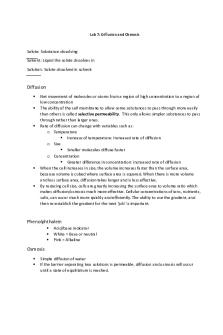Lab 6 Study Guide - Diffusion & Osmosis PDF

| Title | Lab 6 Study Guide - Diffusion & Osmosis |
|---|---|
| Course | General Biology I Lab |
| Institution | Tennessee State University |
| Pages | 2 |
| File Size | 68 KB |
| File Type | |
| Total Downloads | 113 |
| Total Views | 141 |
Summary
study guide for quizzes 6...
Description
Study Guide – Biology 1111 Diffusion & Osmosis Lab o o o o
Benedict’s reagent (test for sugar) Iodine reagent (test for starch) Brown paper (test for lipid) Biuret reagent (test for protein)
Positive – Yellow, Orange, Red Positive – Dark Blue Positive – Soaks into Paper Positive – Violet
***Sucrose hydrolyzes into Glucose and Fructose*** Definitions Solvent – dissolving agent
Solute – dissolved substance
Selective Permeability – some substances can cross the plasma membrane easier than others Osmosis – the diffusion of water across a selectively permeable membrane Tonicity – the ability of a surrounding solution that causes a cell to gain or lose water Isotonic – solute concentration is the same as that inside the cell – no net movement Hypertonic – solute concentration is GREATER than that inside the cell – cell LOSES water `
Hypotonic – solute concentration is LESSER than that inside the cell – cell GAINS water ***Plant cells prefer a hypotonic solution*** In a hypertonic environment, plant cells LOSE water which leads to a lethal effect, Plasmolysis
Turgid – a plant cell in a hypotonic solution that swells until the wall opposes uptake Flaccid – a plant cell in an isotonic solution with no net movement of water into the cell - wilting Reminder The purpose of this lab was to investigate the characteristics of the molecules that facilitate diffusion, the factors that can influence diffusion rates and the diffusion of solutes through a selective permeable membrane (dialysis tubing). Our results of our Diffusion & Osmosis lab showed that after 30 min our dialysis tubing containing our glucose solution was not only present inside the tubing, but also was present outside the tubing— proving our hypothesis
Enzymes Lab The purpose of this lab was to use an inhibitor PTU to influence the activity of catechol oxidase to determine if PTU is a competitive or noncompetitive inhibitor.
Definitions Enzymes – biological catalysts – catalytic protein Catalysts – a chemical agent that speeds up a reaction without being consumed by the reaction Substrate – the reactant that an enzyme acts on Enzyme-Substrate Complex – formed when an enzyme binds to its substrate Active Site – the region on the enzyme where the substrate binds ***Enzymes are effected by or are sensitive to: Temperature - PH - BOTH Inhibitors - Chemicals*** Competitive Inhibitors – bind to the active site of an enzyme and compete with the substrate Noncompetitive Inhibitors – bind to another part of an enzyme, causing a shape change to the enzyme – making the active site less effective Cofactors – non protein enzyme helpers – inorganic Metals– Iron, Magnesium, Zinc Coenzymes – organic cofactors – vitamins – A, D, K, E Reminder Our results of the Enzyme lab showed that the use of the inhibitor PTU to influence the activity of catechol oxidase was a noncompetitive inhibitor—proving our hypothesis...
Similar Free PDFs

Diffusion and Osmosis lab
- 3 Pages

Diffusion & Osmosis Lab
- 10 Pages

Diffusion and osmosis lab
- 4 Pages

Diffusion and Osmosis lab
- 4 Pages

Lab 4 - Diffusion and Osmosis
- 6 Pages

Lab 4 Diffusion and Osmosis
- 7 Pages

Lab 7: Diffusion and Osmosis
- 2 Pages

Lab 5 Diffusion and Osmosis
- 1 Pages

Diffusion and osmosis lab 1
- 4 Pages

Diffusion and Osmosis Lab Report
- 8 Pages

Diffusion and Osmosis Lab Report
- 8 Pages

Diffusion and Osmosis Worksheet
- 2 Pages
Popular Institutions
- Tinajero National High School - Annex
- Politeknik Caltex Riau
- Yokohama City University
- SGT University
- University of Al-Qadisiyah
- Divine Word College of Vigan
- Techniek College Rotterdam
- Universidade de Santiago
- Universiti Teknologi MARA Cawangan Johor Kampus Pasir Gudang
- Poltekkes Kemenkes Yogyakarta
- Baguio City National High School
- Colegio san marcos
- preparatoria uno
- Centro de Bachillerato Tecnológico Industrial y de Servicios No. 107
- Dalian Maritime University
- Quang Trung Secondary School
- Colegio Tecnológico en Informática
- Corporación Regional de Educación Superior
- Grupo CEDVA
- Dar Al Uloom University
- Centro de Estudios Preuniversitarios de la Universidad Nacional de Ingeniería
- 上智大学
- Aakash International School, Nuna Majara
- San Felipe Neri Catholic School
- Kang Chiao International School - New Taipei City
- Misamis Occidental National High School
- Institución Educativa Escuela Normal Juan Ladrilleros
- Kolehiyo ng Pantukan
- Batanes State College
- Instituto Continental
- Sekolah Menengah Kejuruan Kesehatan Kaltara (Tarakan)
- Colegio de La Inmaculada Concepcion - Cebu



